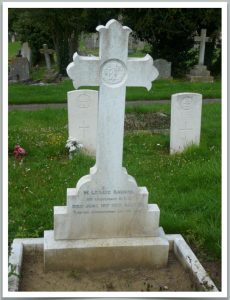Royal Flying Corps

William Leslie Savage was the son of Arthur, a colonial merchant and his wife Rose Mary who had been born in Cape Colony, South Africa.
He was born on 15 November 1898 in Surrey and the 1911 Census records the couple having four children.
At the time of that census Leslie was attending boarding school in Eastbourne. The family lived at Thringarth, Egmont Road, Sutton, Surrey.
It would appear that prior to joining the Royal Flying Corps (RFC), Leslie served as a Second Lieutenant with the 2nd Artist’s Rifles (2/28th (County of London) Battalion) London Regiment.
This period of his war service needs to be researched via his National Archives file WO 339/96508.
Upon transfer to the RFC his initial posting was to the School of Military Aeronautics at Reading on 10 March 1917.
He transferred to 24th Reserve Squadron at Netheravon on 13 April 1917, before moving to 38th Reserve Squadron at Rendcomb, Gloucestershire.
He was killed in an aero accident on 16 June 1917 at the age of 18.
Reports of the accident and subsequent inquest were published in various newspapers, notably the Gloucester Journal and Cheltenham Chronicle of 23 June 1917.
Between 6am and 7am on 16 June Savage took off in what was considered a perfectly airworthy aeroplane as an observer under instruction in piloting; the machine was dual control.
The aeroplane was flown by Second Lieutenant Percy Tew (age 28). After a series of ‘circuits and bumps’ at 7.10am the machine was taking a turn to come into land when it suddenly went into a spinning nose dive, from about 60 feet up and crashed into the ground.
Tew was crushed by the engine and killed instantly and Savage was extracted from the wreck, still breathing and taken by ambulance to Cirencester Hospital but was found to be dead on arrival, having suffered ‘frightful’ injuries.
A verdict of accidental death was recorded at the inquest.
Second Lieutenant Tew came from Warwick and his body was taken to Warwick Cemetery for burial.
William Leslie Savage was buried with full military honours in Cirencester Cemetery, where a privately funded stone cross was erected over his grave.
Researched by Graham Adams 30 September 2014
